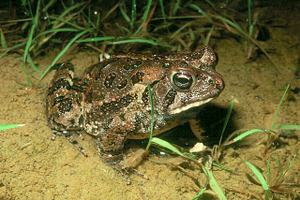This and other toads have toxic skin secretions that help protect them from predators, but skunks and raccoons often eat them without ill effect by avoiding the skin and parotid glands. Hognose snakes (Heterodon) are immune to the toxins and swallow toads whole.
Photo Credit: Geoffrey A. Hammerson
Anaxyrus fowleri
Common Name: Fowler's toad
Other Scientific Names: Bufo fowleri, Bufo woodhousii fowleri
Animal Guild: Amphibian
Class > Order > Family: Amphibia > Anura > Bufonidae
What does the species look like?
The upper surface is brown, grayish, or rarely greenish or red, with a pattern of large dark blotches, the largest of which contain 3 or more warts. Usually there is a light stripe along the middle of the back. The hard ridges behind the eyes contact the parotoid glands (large glandular swellings behind the eyes). The parotoid glands are about twice as long as wide. Maximum snout-vent length is around 3.8 inches (9.5 cm); females grow much larger than males. Mature male can be recognized during breeding season by its dark throat and dark patches present on the inner surfaces of the first and second toes of the front feet. The male's expanded vocal sac is spherical or slightly elongated. Breeding calls are loud "waaaaaah" sounds lasting about 1-4 seconds and emitted up to several times per minute. Larvae are dark brown to black and often mottled. The eyes are positioned high on the head. The fins are mainly clear with sparse pigment flecks, with more in the upper fin than in the lower. Larvae reach a maximum total length of up to 1.1 inches (2.7 cm). Eggs are black above, tan below, 1.0-1.5 mm in diameter; they are deposited in long strings in a single jelly envelope, with single or double row of eggs in each jelly string.
Where is the species found?
States & Provinces
AL, AR, CT, DC, DE, FL, GA, IA, IL, IN, KY, LA, MA, MD, MI, MO, MS, NC, NH, NJ, NY, OH, OK, ON, PA, RI, SC, TN, TX, VA, VT, WV
Distribution
Fowler's toad occurs throughout most of the eastern United States and along the northern shore of Lake Erie in Canada, from southeastern Iowa to southern New Hampshire, and south to eastern Texas, the Gulf Coast, and northern Florida. It is absent from northern New England and the Florida peninsula.
Fowler’s toads inhabit wooded areas, river valleys, and floodplains, including agricultural and residential areas, usually in areas with deep friable soils, up to at least several hundred meters from breeding sites. Breeding sites include shallow water of marshes, rain pools, ponds, lakes, reservoirs, flooded areas, backwaters of rivers, and other bodies of water lacking a strong current.
General Phenology and Life History
These toads are inactive during cold weather in fall, winter, and early spring. Most activity is nocturnal, but daytime activity is not uncommon. During cold weather or drought, toads burrow underground or hide under rocks, plants, or other cover. Breeding occurs in spring or summer (timing varies geographically), often after heavy rains. Male breeding choruses may last a few weeks. Individual females lay clutches of thousands of eggs in long strings. Eggs hatch within about a week and metamorphose into tiny toadlets in 1-2 months.
Which phenophases should I observe?
Do you see/hear...?
Activity
Adults on land More...
For abundance, enter the number of individual animals observed in this phenophase.
Adults in water More...
For abundance, enter the number of individual animals observed in this phenophase.
Adults feeding For abundance, enter the number of individual animals observed in this phenophase.
Reproduction
Vocalizing What is the intensity of vocalizing?
Single calls: There is space between calls and individuals can be counted. Overlapping calls: Calls of individuals can be distinguished but there is some overlapping of calls. Full chorus: Calls are constant and overlapping.
Mating For abundance, enter the number of individual animals observed in this phenophase.
Fresh eggs For abundance, enter the number of individual animals observed in this phenophase.
Development
Dead adults For abundance, enter the number of individual animals observed in this phenophase.
What do these phenophases look like?
There is currently no photoguide available for this species. If you'd like help us create one, use the guidance document and species template provided here . Then send it via email to education@usanpn.org when it is complete.
